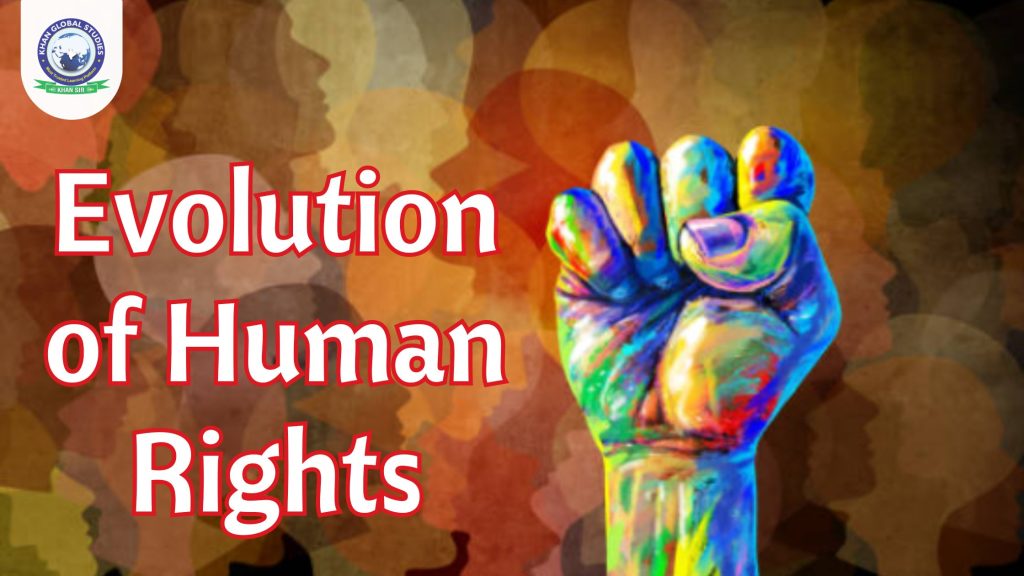Article 1 of the Universal Declaration of Human Rights of 1948 clearly states, “All human beings are born free and equal in dignity and rights.” But what exactly is included in the term “human rights”? How does the essence of “human” in “human rights” contribute to its meaning? Are these rights truly universal? Why are they paramount, and what journey have they taken throughout history? In the 21st century, what is their enduring relevance? These questions form the cornerstone of this exploration. However, before delving into these deeper investigations, it is imperative to understand the basic concept of the evolution of human rights.
What are human rights?
As Andrew Heywood, a distinguished author of numerous political treatises, has explained, human rights represent rights granted to individuals simply under their humanity – the modern, secular equivalent of “natural rights.” These rights are identified by four key characteristics.
First, human rights are universal, belonging to every person regardless of race, religion, caste, creed, or other differentiating factors. Secondly, they are fundamental, which reflects their essential importance. Thirdly, these rights are absolute, which underlines their inherent necessity for every individual. Finally, they are indivisible, which means that all aspects of human rights – be they civil, economic or social – are equally important.
In short, human rights are the privileges that every individual enjoys simply by being human. The most important aspect to remember about these rights is their universality – they apply to all human beings regardless of nationality, race, religion or other distinctions.
The Evolution of Human Rights and Their Variations
It is challenging to pinpoint the exact moment when the concept of human rights first emerged. Many cultures and traditional societies have long upheld the inherent value of each individual as a human being. However, it was in early modern Europe that the notion of human rights began to crystallize as “natural rights”. Thinkers such as John Locke, Thomas Hobbes and Hugo Grotius declared certain rights to be natural, fundamental to human existence and central to human nature. Several early milestones are considered important, contributing to the nascent concept of human rights.
These important historical milestones include the Magna Carta of 1215, the Bill of Rights of 1688, the U.S. Declaration of Independence of 1776, and the 1789 Code of Human and Civil Rights in France. Humanitarian ethics evolved over the centuries, as did gradual efforts to enforce rights. For example, the Congress of Vienna in 1815 tried to pursue the abolition of the slave trade, a goal that was eventually realized through the Brussels Convention of 1890. Although many of these efforts were made by states for the benefit of their citizens, they laid the groundwork for the language of rights.
Still, the concept of universal human rights gained significant momentum only after the devastating world wars. In 1948, the United Nations adopted the Universal Declaration of Human Rights during its General Assembly. By 1966, two important documents – the International Covenant on Civil and Political Rights and the International Covenant on Economic, Social and Cultural Rights – were adopted, both of which came into force in 1976.
Karel Vasak, a renowned scholar of human rights, introduced the concept of three generations of human rights, which provides a framework for understanding the types and development of these rights. The first generation includes civil and political rights; the second generation includes economic, social and cultural rights; and the third generation includes rights to solidarity.
First-generation rights, which focus on civil and political liberties, are the earliest form of natural rights. These rights emerged during the English Revolution of the 17th century and the French and American Revolutions of the 18th century. The central theme of these rights is freedom. They include the rights to life, liberty and property, as well as the rights to non-discrimination, freedom from arbitrary arrest, freedom of thought, religion and movement. These rights are often seen as expressions of negative rights, as they are best enjoyed when there are restrictions on others. Important documents for understanding first-generation rights include Articles 3 to 21 of the United Nations Declaration of Human Rights and the International Covenant on Civil and Political Rights of 1966.
Second-generation rights rose to prominence in the 20th century, particularly after World War II. With economies devastated by war and mass destruction, there was a growing emphasis on economic, social, and cultural rights. These rights, based on socialist principles, emphasize equality in contrast to the first-generation focus on liberty. Second-generation rights include the right to work, healthcare, education, and social security. These rights are seen as positive rights, requiring state action and duties such as welfare provisions. Important documents for understanding second-generation rights include Articles 22 to 27 of the United Nations Declaration of Human Rights and the International Covenant on Economic, Social and Cultural Rights of 1966.
Third-generation rights that emerged after 1945 are called solidarity rights. These rights focus on social groups and society rather than individuals, making them collective rights. The main theme of third-generation rights is fraternity. These rights often address challenges faced by countries in the global south and include the right to development, environmental protection, self-determination, and peace. The 1972 Stockholm Convention on the Human Environment and the 1992 Earth Summit in Rio are important documents to understand these rights.
The Way Forward
With a clear understanding that the evolution of human rights are innate rights that every individual has from birth, it becomes imperative for us to be aware of these rights and exercise them judiciously without infringing on the rights of others, as such actions can be a violation of human rights.
Human rights have been interpreted differently by different communities and nations over time. As history has unfolded, these rights have evolved, acquiring new meanings and definitions. The evolution of human rights has also faced challenges, with significant events sparking major debate. A recent example of this is the repeal of the right to abortion in the United States following the Dobbs v. Jackson Women’s Health Organization (2022) decision.
Although the future of human rights remains uncertain, it cannot be denied that the protection of these vital rights is essential to promote peace and restore faith in humanity.




